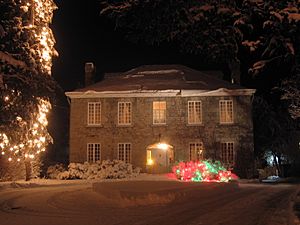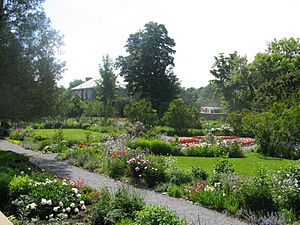Maplelawn facts for kids
Quick facts for kids Maplelawn & Gardens |
|
|---|---|

Maplelawn in winter 2006
|
|
| Location | Ontario, Canada |
| Nearest city | Ottawa |
| Built | 1834 |
| Original use | Residence and walled garden |
| Current use | Restaurant |
| Governing body | National Capital Commission |
| Designated | 1989 |
Maplelawn is a historic house and former estate in Ottawa, Ontario, Canada. The house was built between 1831 and 1834. It was the main building of a large farm owned by the Thomson family.
In 1877, the Cole family bought the estate. They lived there until 1989. Today, the National Capital Commission owns Maplelawn. It is a special national historic site. Maplelawn is famous for its rare and well-kept walled garden. This garden is called The Maplelawn Garden. Since 1999, Maplelawn has been home to Keg Manor restaurant. You can find the house at 529 Richmond Road in Westboro, Ottawa.
The house's design shows a love for British classicism. This style was popular in Britain. However, some parts, like the windows, have a local look. This local style was common in Quebec and the Ottawa Valley. The walled garden is very unusual for a Canadian farm estate. Walled gardens were popular in Europe. But they were not common in Canada. The Maplelawn garden was made to be both beautiful and useful.
Contents
History of Maplelawn
Around 1818, William Thomson settled on a farm. He was a Scottish gentleman. He had retired from the British Army. His farm was about 200-acre (0.81 km2) big. It was located on the road from Bytown to Richmond village. Thomson and his sons mainly focused on farming. But they also invested a little in the lumber business.
The Cole Family at Maplelawn
In 1877, the Thomsons sold the farm. Thomas Cole bought it. He had earned a lot of money in the lumber industry. The Cole family and their children owned the house for many years. They kept it until 1989. That's when Frances Rochester passed away. She was Thomas Cole's granddaughter. Frances and her husband, Lloyd Rochester, lived at Maplelawn. They raised their children there. The Rochesters were another old Ottawa family.
A big change happened in 1936. The old summer kitchen was replaced. The field workers' sleeping area was also removed. A new stone part was added to the back of the house. At the same time, the garden was redesigned. A plant expert from the Central Experimental Farm helped with this. The Federal District Commission bought the house in the 1950s. This group later became the NCC. They bought it to make sure it would be saved.
Maplelawn was named a National Historic Site of Canada in 1989.
Saving the Garden
For some years, the house was empty. The garden started to get damaged. But in 1993, a group of volunteers started working. They were called the Friends of Maplelawn Garden. They helped fix up the garden. The NCC also fixed up the building.
Soon after, Peter Fallis rented the property. He did a huge renovation. He changed both the inside and outside. Mr. Fallis spent a lot of money. He turned the building from a family home into a beautiful restaurant.
Maplelawn as a Restaurant
The new restaurant changed the 1933 addition. This back part of the building became a bar and waiting area. The bar had a great wooden counter. A large fireplace welcomed guests in winter. In warmer months, flowers from the walled garden decorated the bar. French doors on the west side led to a big stone patio. This was an outdoor area for guests. A landscape architect greatly improved these outdoor spaces.
Inside the front of the house, on the main floor, were two dining rooms. Both had fireplaces. They shared a fancy design that was seen throughout the house. The dining rooms had tables for two people. Some tables could change from square for four people to round for six. This was a very clever design. All the tables had special Chippendale chairs. These chairs had beautiful fabric seats.
The house has a grand main entrance at the front. But it was not used when the restaurant was open. The main entrance was at the back of the building. It was near the new parking lot. Sparkling chandeliers hung in every room and hallway. A local artist also made wall lights. These gave extra light to all dining rooms on both floors. All rooms had deep-set windows. This was because of the thick stone walls. These windows were (and still are) amazing. Their sills were perfect for flowers and candles.
A main, curving staircase led to the upper dining areas. This staircase had an amazing mural painted on its curved wall. The mural was painted by Peter Langlois and Dana Wardrop. It led visitors to the stunning second floor.
The second floor had two dining rooms. One was large, and one was small. It also had a unique, one-person washroom. This bathroom also had murals on its walls. But the most interesting part was the original bathtub. It was used as a planter! Several tropical and flowering plants grew in the bathtub. It was filled with earth. Being in this washroom felt like being in a garden oasis. It was a tribute to the walled Victorian garden.
The kitchen was also unique. It was created on the second floor of the house. The kitchen was great to work in. It had rows of windows that let sunlight fill the room. This made it a very cheerful place to work. At first, they hoped to send food down to the main floor. They planned to use an automatic dumbwaiter. It would land in the bar area. But this idea did not work as well as they hoped. The device was expensive but never used for food. So, the restaurant went back to using people. They carried food down the stairs on large oval trays.
Unfortunately, the Maplelawn Cafe faced challenges. It did not last long enough to become the great restaurant it could have been. Several problems, including a big ice storm in 1998, caused the restaurant to close. The NCC benefited from the changes Peter Fallis made to the house. Because the property was changed from a home to a restaurant, the NCC could rent it to another restaurant. This new restaurant needed very few improvements. In the late 1990s, new business owners took over the lease. They created a franchise of The Keg restaurant. It was called "Keg Manor" and opened in the house.
Images for kids




